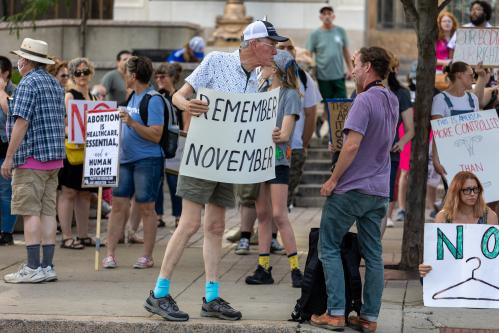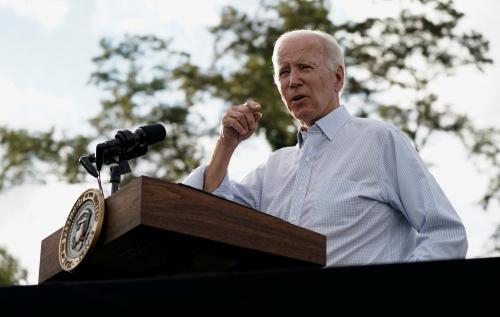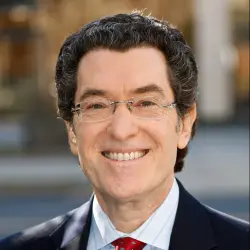This blog post has been revised to include a link to the Presidential Commission report.
In late June, the Supreme Court overturned Roe v. Wade in a landmark decision grossly out of step with how Americans feel about abortion. Polling immediately following the Roe reversal showed it exacerbated already crashing public trust in the Court and its neutrality, further endangering a crucial democratic institution. Restoring faith in the Court is an essential undertaking in order to preserve our democratic institutions. Among the most discussed proposals to restore trust in the Court are tenure limits on justices. We favor them because they would help restore confidence in the institution as an independent judicial body insulated from partisan concerns and address the Court’s legitimacy crisis.
At the end of 2021, Chief Justice Roberts’ Year-End Report on the Federal Judiciary stressed the importance of a Court empowered by its institutional independence, insulated from “inappropriate political influence” to ensure a preservation of public trust. Despite this, Americans have their doubts: of the 84 percent who say that justices should keep their political views out of their decisions, only 18 percent feel they do it well. Polling also shows that only 48 percent of Americans now have a favorable opinion of the Court two and a half months following Dobbs—down from 54 percent in January 2022 and 70 percent in July 2020. In their disapproval, Americans are looking for change—67 percent are in favor of term limits.
Judicial appointments are also increasingly contentious. The recent appointments of Justices Kavanaugh and Brown Jackson were characterized by a type of partisan infighting that had died down since the now long-ago hearings of Bork and Thomas. The days of justices receiving over 90 votes ended with the late Justice Ginsburg’s confirmation in 1993.
The court is losing the faith of the American people. Something must be done. Ours is an enterprise in which the rule of law, rather than the rule of the individual, plays a central part. Above all, the nation’s highest court is crucial for this. A variety of options to restore trust exist, and we review them now before turning to our preferred choice of term limits. For additional examination of the ideas laid out by the authors here, readers may refer to the Final Report of the Presidential Commission on the Supreme Court, which further reflects the debate on the Court via the expertise of various legal scholars.
More Justices
Of the proposals for changing the structure of the Supreme Court, increasing the number of justices on the bench, sometime disparagingly referred to as court packing, remains the most contentious. Though the Constitution does not stipulate the number of Justices, there have been nine since 1869 when there were nine federal court circuits. President Roosevelt most famously tested that norm in 1937 in his push to add seats to the Court after the justices stymied his New Deal ambitions. The Senate Judiciary committee sent a negative recommendation to the Senate regarding the proposal: “The bill is an invasion of judicial power such as has never before been attempted in this country…” The bill summarily failed—but the Supreme Court appeared to get the message and began moving the New Deal proposals through.
In the period following the late Justice Ruth Bader Ginsburg’s death, there were calls to expand the Court if then-Senate Majority Leader Mitch McConnell were to work with former President Trump to replace her. Senator Markey of Massachusetts tweeted that “If he [McConnell] violates it, when Democrats control the Senate in the next Congress, we must abolish the filibuster and expand the Supreme Court.” Representative Nadler of New York echoed those sentiments. To take one example of how to do that, expanding the Court to thirteen would match the current number of federal court circuits. However, opponents would undoubtedly use the filibuster (and the related requirement of 60 votes to end debate) to block this. Thus, doing so would require a filibuster ‘carve-out’ majority vote to change the filibuster rules. That would lower the threshold to a simple 51-vote majority to end debate, at least on the number of justices. Senator McConnell previously used such a carve-out strategy in 2017 to reduce the number of votes to confirm new justices from 60 to a simple majority and confirm Justice Gorsuch.
But even though Democrats have 51 votes in the current Senate (including the Vice President as the tiebreaker in the evenly divided Senate), they were unable to muster the votes for filibuster reform for other purposes. And although one of the authors (Eisen) is open to this approach, and the other (Matsuki) less so, we acknowledge that political difficulties aside, increasing the number of justices as a means of restoring legitimacy bears risks. The public might view the expanded Court as serving the party with the greatest number of appointed justices when Americans already overwhelmingly feel that justices are doing a poor job of keeping their politics out of decisions. Moreover, once the norm of nine justices is changed, each party may keep expanding from the Court and appointing more justices once it controls the presidency and has the requisite votes in the Senate. Rather than salvage the Court’s neutrality, more justices might affect the image of SCOTUS as another partisan battleground, affecting hopes of rehabilitating their judicial independence and trust.
Age Limits
Age limits on Supreme Court justices offer another possible solution to the issues posed by lifetime appointments. The Senate attempted to implement them in 1954 by consideration of a constitutional amendment that would have created a mandated retirement age of 75 for all federal judges. Soon after however, political energy shifted, and the amendment was abandoned as attention turned to the fight against desegregation with Brown v. Board of Education. Today, age limits could appear as a straightforward solution to the Court’s image woes. Justices would serve their terms and retire at a predetermined age, going on to continue serving on lower courts and taking on senior status. Several state supreme courts utilize age limits, such as Massachusetts and New Jersey, so proponents may point to these examples as instances where this policy works effectively at the state level.
Implementation for the Supreme Court, however, raises several fundamental issues. First, we don’t support age discrimination. Second, future presidents might seek to evade this limit by nominating younger and younger nominees to extend their impact on the Court. We have already seen this trend but it risks being extended to an unsound degree. Justices might continue to maintain their appointments for equally extended periods as at present. The system could end up functioning essentially the same as the current lifetime appointments, defeating the purpose of installing age limits. Third, by looking for younger nominees, presidents would run the risk of skipping over highly qualified judges whose time on the Court would improve the quality of decisions and public standing of the institution, despite their age. But there is another chronological solution that avoids these disadvantages, and we turn to it now.
Tenure Limits
Tenure limits are a more robust alternative. They would ensure a cyclical and predictable turnover, something that Justices Kagan, Breyer, and Roberts have reflected on as positives for the Court. This would allow for new minds to join regularly and ensure one president or party does not have an outsized influence on the Court and trajectory of constitutional review for decades to come—with each president likely being able to appoint a justice at least once or twice during his or her term in the White House. An increase in turnover would also mean justices are less insulated from everyday life and more in touch with the direction of legal analysis on particularly contentious issues.
Tenure limits require determining exactly what the length of service should be. Current proposals have floated 18-year, nonrenewable terms, as in a 2021 bill by Representatives Khanna, Beyer, Lee, and Tlaib. A new justice would be appointed every two years on this plan, with current justices being exempt. This 18-year term length is shorter than the current average of about 25 to 26 years for justices who have left the Court since 1970, but term limits are in part designed to encourage turnover. Terms shorter than the current average are thus an advantage of the proposal. Since the terms would be nonrenewable, there would be an increase in the number of retired Supreme Court justices. Already, justices tend to take on senior status post retirement and continue to perform judicial duties such as sitting on lower appellate courts when needed.
Fortunately, shifting the structure of term length on the Supreme Court would not put it out of touch with other levels of the American judiciary: nearly all states have some form of term or age limits on their supreme courts. Rhode Island is the one state with a life term and no mandated retirement age.
Conclusion
The Supreme Court should be a body that is independent and insulated from partisanship. Instead, it has become a battleground for political infighting. The way Americans feel about the Court reflects this increasing partisanship and politicization. Though it would not be easy, changing the way that tenure functions would be an important step towards rebuilding public trust in the Court’s capability as an independent body, removing it from beneath the specter of partisan politics.
There is strong appetite for change. Fifty-seven percent of Republicans, 82 percent of Democrats, and 51 percent of Independents are in favor of setting a specific number of years that Supreme Court justices serve instead of life terms. Though respondents were not offered a specific proposal or terms, representatives have already attempted to move the needle in favor of term limits—specifically 18-year, nonrenewable terms as discussed above. Moreover, 7th Circuit Judge Diane Woods said she found the 18-year term limit idea “ambitious” and “intriguing”.
Notwithstanding these kinds of poll numbers and public comments it might seem that the current gridlock will not lend itself to change. On the other hand, we do not know what the situation will look like after November or in the years ahead. Given all the frustration and pressures that have built up in and around the Court, there may be a sufficient number of votes in Congress. It is important to start socializing the idea of reforms now—sometimes they are upon us quicker than we think.
The Brookings Institution is committed to quality, independence, and impact.
We are supported by a diverse array of funders. In line with our values and policies, each Brookings publication represents the sole views of its author(s).









Commentary
Term limits—a way to tackle the Supreme Court’s crisis of legitimacy
September 26, 2022